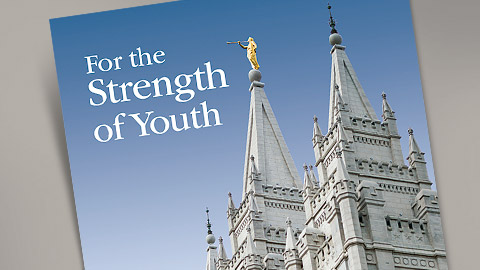 The booklet For the Strength of Youth has been updated to address issues and challenges youth face today that were not specifically addressed in the previous version of the booklet last updated in 2001.
The booklet For the Strength of Youth has been updated to address issues and challenges youth face today that were not specifically addressed in the previous version of the booklet last updated in 2001.
Printed copies of the booklet and accompanying cards are being shipped in 41 languages to youth, parents, and leaders around the world.
 An online version of For the Strength of Youth is available on the Church’s website for youth at https://www.churchofjesuschrist.org/study/manual/for-the-strength-of-youth?lang=eng. The online version provides additional information, including links to related videos and articles.
An online version of For the Strength of Youth is available on the Church’s website for youth at https://www.churchofjesuschrist.org/study/manual/for-the-strength-of-youth?lang=eng. The online version provides additional information, including links to related videos and articles.
Youth can share their own experiences on each of the topics in the booklet and read the experiences of other youth.


We used this booklet for a series of FHE lessons when our young people were that age, and it has been a great resource. Extremely well written to age level.
However, I winced when I saw this cover. There are no youth here, instead there is this gray temple. A strange temple that most LDS will never visit, and may not even recognize. It comes across as SLC trying to dictate to those of us out in the trenches, and feeds the myth that the genuine church is in Utah while the rest of us are mere mimics who can never live up to the real thing.
Please try to convey to your colleagues at the church office building that the SLC temple is NOT a symbol that has much meaning to most members of the church. Or if it does have symbolism, it is of Yankee imperialism. It doesn’t have the same meaning in Tennessee or Sao Paulo that it does in Utah. Please, please consider stopping using it on so many church materials.
The gospel is great because it works throughout the world, transcending cultural differences. So church materials should avoid local cultural references whenever possible. I’d rather see a group of culturally diverse young people who are happy because they are living these standards. That is the true symbol.
I really disagree with Naismith on that. I am from Brazil and the SLC temple has a lot of meaning to us. We do not see ourselves separate from the early Utah saints and pioneers, we are their descendants. As pioneers in our own country, we feel very connected to the history of the early church and even with Utah. I see that you are trying to be culturally sensitive but do not make the assumption that people around the world has the same view as you. Most members in the area where I came from, do not make that type of association.